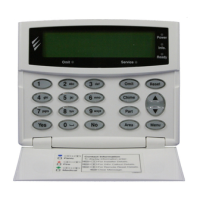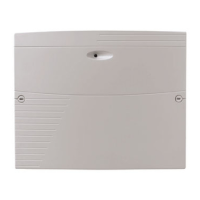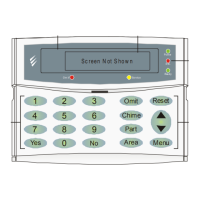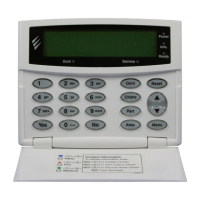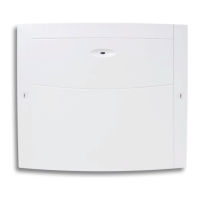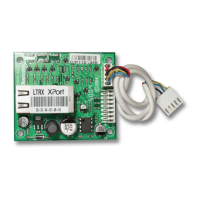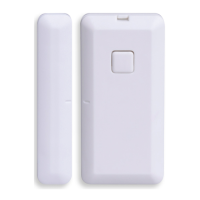Programming the Control Panel Premier 48, 88, 168 & 640 Installation Manual
62 INS176
16 - Digi Successful
This output type activates when the plug-on communicator
successfully reports to the Alarm Receiving Centre and
deactivates the next time the communicator is triggered.
17 - Digi Active
This output type activates when the plug-on communicator is
triggered and deactivates when the communicator shuts down.
18 - UDL Lockout
This output type activates when an attempt is made to
upload/download with incorrect site details more than three times
and deactivates after 4 hours or after a valid User code is entered.
19 - UDL Call Active
This output type activates when an upload/download is started
and deactivates when the upload/download finishes.
20 - UDL Enabled
This output type activates when ‘Enable UDL/Engineer’ is
enabled and deactivates when ‘Enable UDL/Engineer’ is
disabled (see page 88 for details).
21 - Confirmed Alarm
If the system is already in alarm, this output type activates
when a different zone (not on the entry route) is activated and
deactivates at the end of the ‘Confirmation’ time, when a code
is entered within the ‘Abort’ time or when the alarm is reset.
22 - Custom1 Stage A
This output type operates when ‘Custom Output 1’ Stage A
activates and deactivates when ‘Custom Output 1’ Stage A
deactivates.
23 - Custom1 Stage B
This output type operates when ‘Custom Output 1’ Stage B
activates and deactivates when ‘Custom Output 1’ Stage B
deactivates.
24 - Custom1 Stage AB
This output type operates when ‘Custom Output 1’ Stage A or
B activates and deactivates when ‘Custom Output 1’ Stage A
deactivates.
25 - Custom2 Stage A
This output type operates when ‘Custom Output 2’ Stage A
activates and deactivates when ‘Custom Output 2’ Stage A
deactivates.
26 - Custom2 Stage B
This output type operates when ‘Custom Output 2’ Stage B
activates and deactivates when ‘Custom Output 2’ Stage B
deactivates.
27 - Custom2 Stage AB
This output type operates when ‘Custom Output 2’ Stage A or
B activates and deactivates when ‘Custom Output 2’ Stage A
deactivates.
28 - Radio-Pad Failed
This output type activates when the radio pad fails to
communicate with the Alarm Receiving Centre and
deactivates when the radio pad successfully communicates.
29 - Radio Successful
This output type activates when the radio pad successfully
communicates with the Alarm Receiving Centre and deactivates
when the radio pad fails to successfully communicate.
30 - No Radio Signal
This output type activates when the Radio-Pads forward signal is
lost and deactivates when the signal is regained.
31 - Radio-Pad Lost
This output type activates when the Radio-Pad stops
communicating with its base station or the control panel and
deactivates when communication starts again.
32 – Custom3 Stage A
This output type operates when ‘Custom Output 3’ Stage A
activates and deactivates when ‘Custom Output 3’ Stage A
deactivates.
33 - Custom3 Stage B
This output type operates when ‘Custom Output 3’ Stage B
activates and deactivates when ‘Custom Output 3’ Stage B
deactivates.
34 - Custom3 Stage AB
This output type operates when ‘Custom Output 3’ Stage A or
B activates and deactivates when ‘Custom Output 3’ Stage A
deactivates.
35 - Custom4 Stage A
This output type operates when ‘Custom Output 4’ Stage A
activates and deactivates when ‘Custom Output 4’ Stage A
deactivates.
36 - Custom4 Stage B
This output type operates when ‘Custom Output 4’ Stage B
activates and deactivates when ‘Custom Output 4’ Stage B
deactivates.
37 - Custom4 Stage AB
This output type operates when ‘Custom Output 4’ Stage A or
B activates and deactivates when ‘Custom Output 4’ Stage A
deactivates.
38 - Com 1 Fault
This output type activates when whatever is connected to
Com Port 1 stops communicating with the control panel and
deactivates when communication starts again.
39 - Com 2 Fault
This output type activates when whatever is connected to
Com Port 2 stops communicating with the control panel and
deactivates when communication starts again.
40 - Com 3 Fault
This output type activates when whatever is connected to
Com Port 3 stops communicating with the control panel and
deactivates when communication starts again.
41 - Com 1 No Signal
This output type activates when whatever is connected to
Com Port 1 loses its signal and deactivates when its signal is
regained.
42 - Com 2 No Signal
This output type activates when whatever is connected to
Com Port 2 loses its signal and deactivates when its signal is
regained.
43 - Com 3 No Signal
This output type activates when whatever is connected to
Com Port 3 loses its signal and deactivates when its signal is
regained.
44 - Coms Fault
This output type activates whenever any type of
communication fault occurs i.e. No Signal, Com Port Fault, line
fault etc. and deactivates when communication starts again.
45 - Radio Jamming
This output type activates whenever the wireless radio
receiver detects a jamming signal and deactivates when the
jamming signal is removed.
46 - Radio RX Tamper
This output type activates when the wireless radio receiver lid
is removed, causing a Tamper alarm on the system, and
deactivates when the Tamper alarm is reset.

